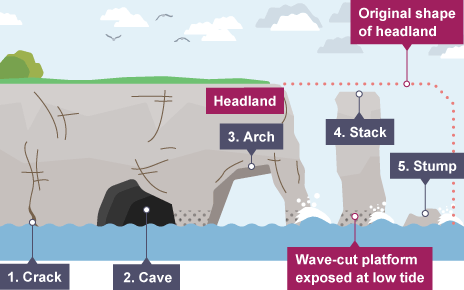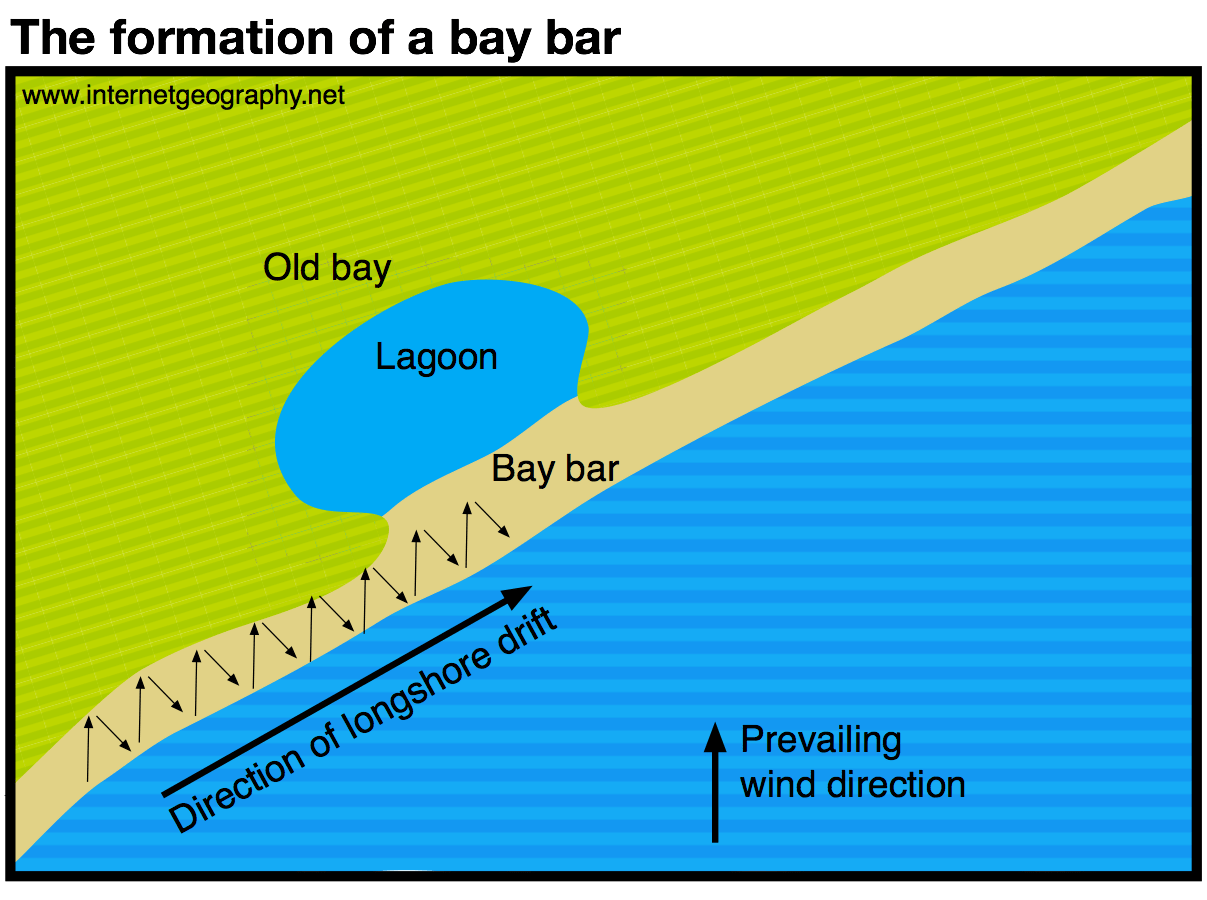Physical landscapes in the UK (coasts and rivers)
1/15
There's no tags or description
Looks like no tags are added yet.
Name | Mastery | Learn | Test | Matching | Spaced |
|---|
No study sessions yet.
16 Terms
what are types of weathering that takes place in coastal areas?
freeze thaw
carbonation
solution
mechanical weathering
chemical weathering
biological weathering
dissolved carbon dioxide in rainwater
How are stacks formed?
Cracks are formed in the headland through the erosional processes of hydraulic action and abrasion.
As the waves continue to grind away at the crack, it begins to open up to form a cave.
The cave becomes larger and eventually breaks through the headland to form an arch.
The base of the arch continually becomes wider through further erosion, until its roof becomes too heavy and collapses into the sea. This leaves a stack (an isolated column of rock). An example of a Welsh stack can be found at Stack Rocks, Pembrokeshire.
The stack is undercut at the base until it collapses to form a stump.

How is a spit formed?
Sediment is carried by longshore drift.
When there is a change in the shape of the coastline, deposition occurs. A long thin ridge of material is deposited. This is the spit.
A hooked end can form if there is a change in wind direction.
Waves cannot get past a spit, therefore the water behind a spit is very sheltered. Silts are deposited here to form salt marshes or mud flats.
Why are some waves larger than others?
The strength of the waves
The distance the wind had been blowing for (fetch)
How long the wind has been blowing for
What happens when the wave reaches the shore?
The base of the wave is slowed by friction - the top of the wave continues until it topples. The water rushing up the beach is called the swash + the water travelling back out to the sea is called the backswash
What are destructive waves?
Powerful and cause erosion
Tall and steep
Closely spaced
Occur bet. 11-15 times per minute
Backswash is stronger than the swash - material is taken away from the shore
What is a constructive wave?
Less energy and cause deposition
Low in height + widely spaced
Occur bet. 6-9 times per minute
Swash is stronger then backswash + material is added to shore
How is sediment moved along the coast?
Longshore drift moves sediment along the coastline
A prevailing wind hits the shore at a 45 degree angle + swash follows this angle taking sediment with it
Waves then move back at a 90 degree angle due to gravity
90 degree angle = backswash
The process continues in a zig zag motion moving sediment along the coastline
What is a bar?
The process of longshore drift transports sediment along the coast until there is a bay or river mouth
Sand is deposited leaving a ridge (the same as a spit)
The ridge cuts off the bay/ mouth trapping freshwater behind it

What are the different Shorline Management Plans (SMP)?
Areas can choose to put in place one of these 4 policies:
No Intervention: Allows nature to take its course
Hold the line: Maintain existing coast by building coastal defences
Managed Realignment: Allows nature to take its course but direct the process
Advance the Line: build new defences
Examples of Soft Engineering
Beach replenishment - adding sand or shingle to the beach through dredging
+ Attracts toursism and abosrbs more wave energy
- Expensive to maintain and can affect tourism
Sand dune regeneraion - grasses, bushes and trees planted to stabilise the dunes
+ Cheap and creates habitats
- Vegetation takes time to grow and access to unes are limited
Examples of Hard Engineering
Sea wall - concrete wall built at the foot of cliffs to reflect the waves back out to sea
+ Effective at stopping the sea
- Expensive
Groynes - wooden or rock structures built out to sea to trap sand from longshore drift
+ Quick construction and bigger beach = toursim
- Cause erosion down the coast
What is air compression?
Trapped air compresses and shatters